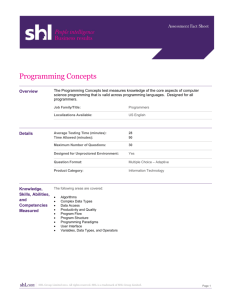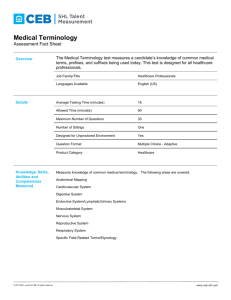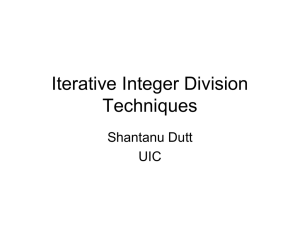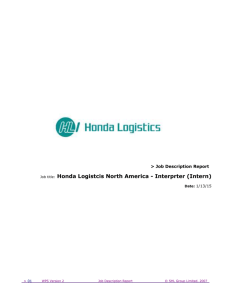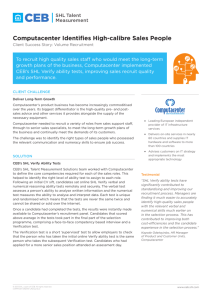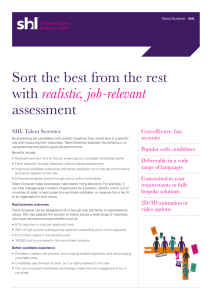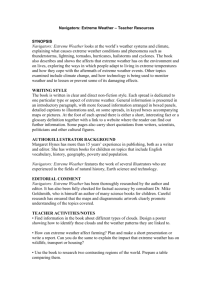Category 2 Project Narrative – Pass 2
advertisement
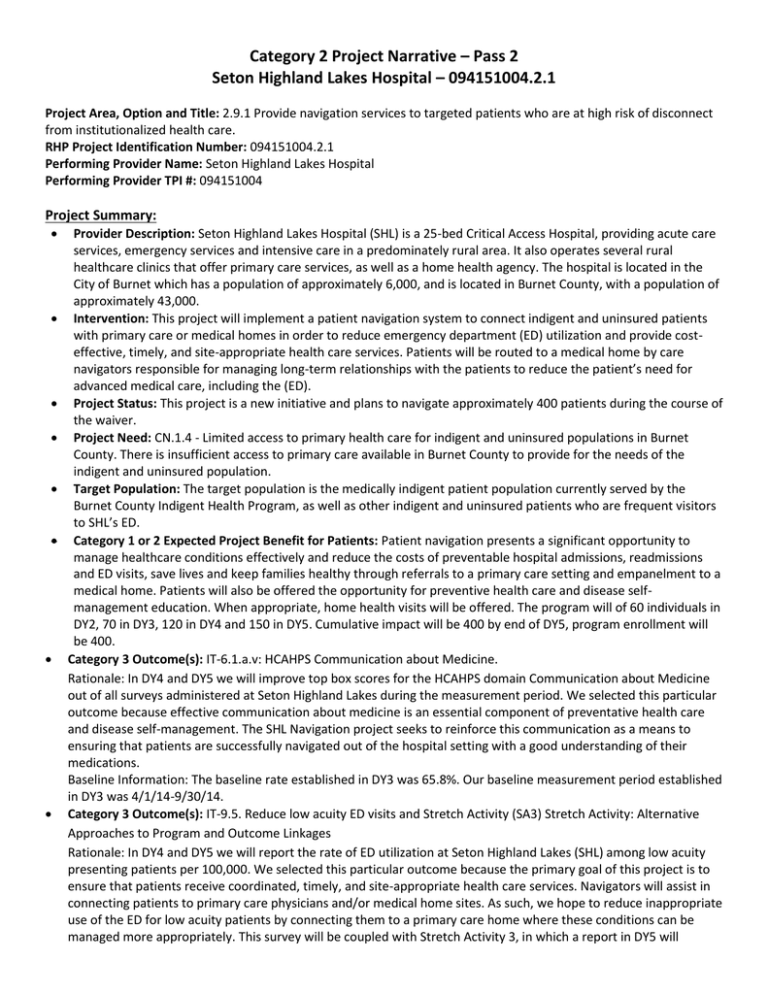
Category 2 Project Narrative – Pass 2 Seton Highland Lakes Hospital – 094151004.2.1 Project Area, Option and Title: 2.9.1 Provide navigation services to targeted patients who are at high risk of disconnect from institutionalized health care. RHP Project Identification Number: 094151004.2.1 Performing Provider Name: Seton Highland Lakes Hospital Performing Provider TPI #: 094151004 Project Summary: Provider Description: Seton Highland Lakes Hospital (SHL) is a 25-bed Critical Access Hospital, providing acute care services, emergency services and intensive care in a predominately rural area. It also operates several rural healthcare clinics that offer primary care services, as well as a home health agency. The hospital is located in the City of Burnet which has a population of approximately 6,000, and is located in Burnet County, with a population of approximately 43,000. Intervention: This project will implement a patient navigation system to connect indigent and uninsured patients with primary care or medical homes in order to reduce emergency department (ED) utilization and provide costeffective, timely, and site-appropriate health care services. Patients will be routed to a medical home by care navigators responsible for managing long-term relationships with the patients to reduce the patient’s need for advanced medical care, including the (ED). Project Status: This project is a new initiative and plans to navigate approximately 400 patients during the course of the waiver. Project Need: CN.1.4 - Limited access to primary health care for indigent and uninsured populations in Burnet County. There is insufficient access to primary care available in Burnet County to provide for the needs of the indigent and uninsured population. Target Population: The target population is the medically indigent patient population currently served by the Burnet County Indigent Health Program, as well as other indigent and uninsured patients who are frequent visitors to SHL’s ED. Category 1 or 2 Expected Project Benefit for Patients: Patient navigation presents a significant opportunity to manage healthcare conditions effectively and reduce the costs of preventable hospital admissions, readmissions and ED visits, save lives and keep families healthy through referrals to a primary care setting and empanelment to a medical home. Patients will also be offered the opportunity for preventive health care and disease selfmanagement education. When appropriate, home health visits will be offered. The program will of 60 individuals in DY2, 70 in DY3, 120 in DY4 and 150 in DY5. Cumulative impact will be 400 by end of DY5, program enrollment will be 400. Category 3 Outcome(s): IT-6.1.a.v: HCAHPS Communication about Medicine. Rationale: In DY4 and DY5 we will improve top box scores for the HCAHPS domain Communication about Medicine out of all surveys administered at Seton Highland Lakes during the measurement period. We selected this particular outcome because effective communication about medicine is an essential component of preventative health care and disease self-management. The SHL Navigation project seeks to reinforce this communication as a means to ensuring that patients are successfully navigated out of the hospital setting with a good understanding of their medications. Baseline Information: The baseline rate established in DY3 was 65.8%. Our baseline measurement period established in DY3 was 4/1/14-9/30/14. Category 3 Outcome(s): IT-9.5. Reduce low acuity ED visits and Stretch Activity (SA3) Stretch Activity: Alternative Approaches to Program and Outcome Linkages Rationale: In DY4 and DY5 we will report the rate of ED utilization at Seton Highland Lakes (SHL) among low acuity presenting patients per 100,000. We selected this particular outcome because the primary goal of this project is to ensure that patients receive coordinated, timely, and site-appropriate health care services. Navigators will assist in connecting patients to primary care physicians and/or medical home sites. As such, we hope to reduce inappropriate use of the ED for low acuity patients by connecting them to a primary care home where these conditions can be managed more appropriately. This survey will be coupled with Stretch Activity 3, in which a report in DY5 will address program aims, participation, changes implemented, and quantitative assessment of impact on service delivery and patient outcomes. Baseline Information: The baseline rate established in DY3 was 98.02%. Our baseline measurement period established in DY3 was 4/1/14-9/30/14. Project Description: Patient Care Navigation Provider, SHL, will develop a comprehensive, effective patient navigation services for indigent and uninsured patients from Burnet County, Texas. Patients will be routed to a medical home by care navigators responsible for managing longterm relationships with the patients to reduce the patient’s need for advanced medical care, including the (ED). A collaborative care team of Navigators, including Community or Home Health Workers, Licensed Nurses, and/or Case Managers will provide proactive care management, navigate patients to a medical home, perform home environment assessments, and provide medication management assistance. The care team will also provide education to enrolled patients regarding chronic conditions, disease prevention and medication management. Below are the anticipated roles and responsibilities of the care team of navigators: Medical Director (Physician) and/or Nurse Practitioner: Care management of the most vulnerable enrollees in the care management program. Those patients requiring a higher level of care coordination and oversight, education and medication reconciliation. Coordinator of the Program: Coordinates all activities related to developing enrollment materials, managing enrollment into the care coordination program Director of Home Health and Clinics: Operations oversight of clinics, Home Health & Hospice and development of care coordination program Case Manager, RN: Case Manager RN to be the first point of contact for patients enrolled in the program who can proactively manage preventive and educational visits to enrollees and who can be the first point of contact when enrollees interact with the hospital for complex services. Visiting Nurses: Team of multiple nurse positions who combine to visit, evaluate, educate and coordinate across the continuum care of all enrollees on a regular basis. Social Worker: Team of two qualified social workers at SHL who coordinate care and assist with patient navigation through the care continuum. Pharmacist: Proactively evaluate patient medication lists and assist clinicians with appropriate delivery of medications SHL is an integrated, multi-level healthcare provider which is part of a larger system, Seton Healthcare Family, with provides the region with a full range of adult and pediatric tertiary and trauma care. To facilitate and support the medical home model, SHL will leverage its existing network of nine multi-specialty clinics and its home health and hospice services. It will also develop a network of other healthcare providers and community partners to provide timely access to primary and specialty care and other support services. Care coordinators will work with all of these entities with a goal of providing care in the most appropriate setting. All medical interactions with the enrollees will be managed through the SHL electronic medical record system. Seton has a separate cost center for all activities related to the care coordination program which allows for financial tracking of the resources and investments in the program. The program coordinator, in combination with data from the above sources will develop a monthly activity report which will be used in correlation meetings with other community providers and in quarterly meetings with Burnet County on program progress. Goals and Relationship to Regional Goals: The goal of this project is to ensure that patients receive coordinated, timely, and site-appropriate health care services. Navigators will assist in connecting patients to primary care physicians and/or medical home sites. The target population is estimated at 745 based on the number of indigent or uninsured patients who sought care at SHL between September 2011-August, 2012. Of these, approximately 110 were part of the Burnet County Indigent Health Program. Of the total, 474 visited the ED sometime in the last year. One of the goals of this project is to reduce the number of ED visits per capita by this population each year over the life of the program. Project Goals: The care provided by the care team at the medical home of the enrollees and the relationship they will share with will result in improved access to timely, appropriate and high quality care for the residents of the SHL community. Patients will be enrolled in a medical home program with dedicated home health clinicians including physicians and physician extenders and dedicated care coordinators responsible for managing long-term relationships with the patients and their families. The care team will provide patient education on appropriate disease and prescription self-management. This will include prevention and how to appropriately interact with the SHL system to ensure optimal results at the lowest costs. The entire system will be focused on minimizing the patient’s need for advanced medical care and to manage their care to the most appropriate setting including reduction of the number of ED visits. This Project meets the following Regional Goals: Improving access to timely, high quality care for residents, including those with multiple needs; Increasing coordination of prevention and care for residents, including those with behavioral or mental health needs; and Reducing inappropriate utilization of services. Challenges: The following are major challenges related to implementation of the program: A major challenge of the program is the potential growth of the uninsured or underinsured in the SHL service area and the corresponding strain on implementation and long-term management of the health status of the population. SHL is building a scalable infrastructure complete with appropriate software, staffing and leadership oversight to absorb fluctuations in the size of the population. The program will ultimately rely on compliance by enrollees who have previously not been asked to be compliant with rules and protocols associated with a care management program. Our solution has been to bring skilled, culturally competent and personable healthcare providers to their homes to develop lasting relationships which we believe will ultimately result in improved coordination and care. The program depends largely on the IGT source (Burnet County) which is, in turn, depending on this program remaining financially feasible for them throughout the entire four years. We have developed a collaborative spirit between SHL and Burnet County to proactively address issues and barriers which may arise to impact the viability of the program. 5‐Year Expected Outcome for Provider and Patients: SHL expects to see improvement in ambulatory conditions of patients and a reduction in the number unnecessary hospitalization of the indigent and Burnet County patients enrolled in the program and seeking treatment at a SHL facility. Starting Point/Baseline: This is a new delivery system initiative for RHP 8 and will begin with a gap analysis and program development. The baseline for enrollment begins at 0; with a goal of enrolling 60 individuals into the program by the end of DY2. Rationale: Community Need Addressed: Community Need Area: CN.1 - Limited access to primary care Specific Community Need: CN.1.4 - Limited access to primary health care for indigent and uninsured populations in Burnet County Patient navigators help patients and their families navigate the fragmented maze of doctors’ offices, clinics, hospitals, out‐patient centers, payment systems, support organizations and other components of the healthcare system. Services provided to patients enrolled in this navigation program will include: Coordinating care among providers; Arranging financial support and assisting with paperwork; Assist with transportation needed; Facilitating follow‐up appointments; and Community outreach and building partnership with local agencies and groups. The navigation team will have close ties to the local community and serve as important links between underserved communities and the healthcare system. They also possess the linguistic and cultural skills needed to connect with patients from underserved communities. Patient navigators will be: Compassionate, sensitive, and culturally attuned to the people and community; Knowledgeable about the environment and healthcare system; and Connected with critical decision makers inside the system. SHL selected Process Milestone P-1: Conduct a needs assessment to identify the patient population(s) to be targeted with the Patient Navigator program. This milestone was selected because detailed needs assessment will serve as the basis for design of the program and related materials to best serve the needs of the enrolled patients. Gaps in current services and resources needed to fill those gaps will be a primary focus of the needs assessment. Process Milestone P-3.1, to provide navigator services to targeted individuals was selected to begin in DY2 to serve the community need as soon as possible. SHL selected Improvement Measure I-102, to increase the number of PCP referrals and medical empanelment in DYs 4 and 5 to ensure that the majority of enrollees’ health care needs are managed in a cost-effective, timely and site appropriate manner. Core Project Components: a) Identify frequent ED users and use navigators as part of a preventable ED reduction program. Train health care navigators in cultural competency. Low income patients using the ED for primary care services with social or economic barriers to accessing primary care will be offered navigation services. Patient Navigators will create social services notes in the health record that will be associated with the patients’ medical record by medical record number. These notes will include sections on reason for services, assessment, subsequent referrals and follow‐up activities. Further, Patient Navigators will undergo training in providing culturally competent care and receive education regarding disparities and social determinants of health, community outreach, and chronic disease management. b) Deploy innovative health care personnel, such as case managers/workers, community health workers and other types of health professionals as patient navigators. We plan to utilize bilingual Patient Navigators with a background in community health, social services, mental health, or public health, with experience providing direct care to disadvantaged populations. c) Connect patients to primary and preventive care. The care team will be trained to assess enrollees and their environments and to provide education regarding disease self-management and prevention. Contact with enrollees may occur at three points: 1) when contacted by the patient using a centralized care coordination phone number; 2) through periodic medical home health visits; and 3) when enrollees enter the SHL network and referred to the program, with special attention paid to patients in SHL’s ED. d) Increase access to care management and/or chronic care management, including education in chronic disease selfmanagement. At the initial assessment meeting with the patient and their family, which may occur in their home, patients will be educated on the benefits and inner-workings of the program and chronic disease selfmanagement, if applicable. The patient and/or the family will be proactively contacted and visited by the care team to improve patient compliance in disease self-management. e) Conduct quality improvement for project using methods such as rapid cycle improvement. Activities may include, but are not limited to, identifying project impacts, identifying “lessons learned,” opportunities to scale all or part of the project to a broader patient population, and identifying key challenges associated with expansion of the project, including special considerations for safety-net populations. SHL will conduct periodic internal coordination meetings between multiple areas of the health system and externally with other healthcare providers and nonhealthcare partners in the community to identify best practices and implement or pilot new ideas. How the project represents a new initiative or significantly enhances an existing delivery system reform initiative: Currently, a patient navigation program does not exist for these patients at SHL. SHL offers case management services, but this is typically only offered during an inpatient admission and requires a physician order. This project complements, but does not duplicate other current initiatives funded by the U.S. Department of Health and Human Services, either directly or indirectly or through state initiatives. SHL participates in the Medicare and Medicaid Electronic Health Records Incentive Program for hospitals; extension of this program to SHL-affiliated physician offices and clinics is in development; participation in the EHR program is expected to support the care delivered under this project and coordination between providers. SHL’s parent company, Seton Healthcare, is a participant in the Pioneer ACO, however, it is not expected to serve this project’s target population. SHL also benefits indirectly from the participation of Ascension Health, Seton Healthcare Family’s parent company, in CMS’ Partnership for Patients. Related Category 3 Outcome Measure(s): Category 3 Outcome(s): IT-6.1.a.v: HCAHPS Communication about Medicine. Rationale: In DY4 and DY5 we will improve top box scores for the HCAHPS domain Communication about Medicine out of all surveys administered at Seton Highland Lakes during the measurement period. We selected this particular outcome because effective communication about medicine is an essential component of preventative health care and disease self-management. The SHL Navigation project seeks to reinforce this communication as a means to ensuring that patients are successfully navigated out of the hospital setting with a good understanding of their medications. Baseline Information: The baseline rate established in DY3 was 65.8%. Our baseline measurement period established in DY3 was 4/1/14-9/30/14. Category 3 Outcome(s): IT-9.5. Reduce low acuity ED visits and Stretch Activity (SA3) Stretch Activity: Alternative Approaches to Program and Outcome Linkages Rationale: In DY4 and DY5 we will report the rate of ED utilization at Seton Highland Lakes (SHL) among low acuity presenting patients per 100,000. We selected this particular outcome because the primary goal of this project is to ensure that patients receive coordinated, timely, and site-appropriate health care services. Navigators will assist in connecting patients to primary care physicians and/or medical home sites. As such, we hope to reduce inappropriate use of the ED for low acuity patients by connecting them to a primary care home where these conditions can be managed more appropriately. This survey will be coupled with Stretch Activity 3, in which a report in DY5 will address program aims, participation, changes implemented, and quantitative assessment of impact on service delivery and patient outcomes. Baseline Information: The baseline rate established in DY3 was 98.02%. Our baseline measurement period established in DY3 was 4/1/14-9/30/14. Relationships to Other Projects: Related Category 4, population-Improvement measures (based on hospital data) are: Domain 1 – Potentially Preventable Admissions Domain 2 – Potentially Preventable Readmissions Domain 4 - Patient-Centered Healthcare Relationship to Other Performing Providers’ Projects and Plans for Learning Collaborative: There are three other patient navigation projects in RHP 8: Scott & White Memorial Hospital #137249208.2.1 Scott & White Hospital – Llano #020840701.2.1 Williamson County & Cities Health Department #126936702.2.1 In addition, there are a several projects which are associated with patient navigation. These include Bluebonnet Trials’ Emergency Services Diversion project (#126844305.2.2), Scott & White Hospital – Llano’s Sheriff Transport project (#020840701.2.2) and Williamson County & Cities Health Department’s Paramedicine project (#126936702.1.2). SHL will fully participate in RHP-wide learning collaboratives for projects that directly address patient navigation and chronic care management. Because of the wide scope of such services and the integration of care at all levels, plans to participate in learnings regarding care transitions, enhancement of interpretation services, culturally competent care, palliative care and telemedicine. Regular sharing between providers with similar projects and/or target populations to discuss challenges, ideas and solutions between providers is expected to lead to successful implementation and outcomes for the project throughout the demonstration period. The exchange of ideas between providers may be conducted in-person, by teleconference or electronically. Project Valuation: Project valuation considered costs, cost avoidance, population impact, patient experience, the overall impact to the community, as well as the project’s ability to transform the delivery of healthcare by providing the right care, at the right place, the right time, and in the most cost efficient way for the patient and family unit. SHL is on pace to see more than 18,500 visits in its Emergency Department this year and 1,250+ admissions. SHL is anticipating this program will result in approximately 300 fewer visits per year including inpatient and outpatient resulting in an approximate cost avoidance of $700,000. Patient navigation presents a significant opportunity to manage healthcare conditions effectively and reduce the cost of preventable hospital admissions, readmissions and ED visits, save lives and keep families healthy.
